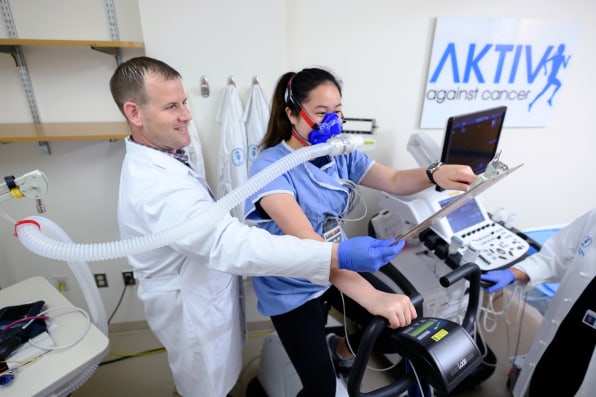- 11.14.19
- WORLD CHANGING IDEAS
A new lifeline for cancer patients comes from astronauts in space
There are notable similarities between how spaceflight affects astronauts and how cancer treatment affects cancer patients. Now doctors are using NASA wellness protocols to help patients on Earth recover.
BY KRISTIN TOUSSAINT3 MINUTE READ
Space exploration has done more than teach us about what lies beyond our atmosphere. It’s led to discoveries that have helped us all here on Earth, from the technology behind CAT scan and MRI machines to the invention of memory foam to new osteoporosis drugs. Now, researchers think that cancer patients could take a cue from the ways astronauts prepare for space travel to keep their bodies healthier as they undergo treatment.
Space travel takes a toll on the human body. Astronauts on months-long missions face muscle atrophy, weakening bones, and increased risk of cardiovascular disease. So do cancer patients, thanks to the intense therapies they receive during treatment.
Whereas astronauts prepare for these health risks with a state-of-the-art exercise regimen before, during, and after their time in space, cancer patients are often told to rest while receiving treatments such as chemotherapy. To Jessica Scott, an exercise physiology researcher at Memorial Sloan Kettering Cancer Center, that seemed a bit backwards.

Writing in the journal Cell, Scott and other researchers suggest that cancer patients mimic astronauts’ exercise schedules—even just walking on a treadmill—as a way to reduce the side effects and stay healthier throughout treatment.
“When you take those … hits together, every system in the human body is impacted,” says Scott. “Astronauts have changes in taste just like [cancer] patients have changes in taste. Astronauts describe having ‘space fog,’ which is very similar to what cancer patients describe as ‘chemo brain,’ where they may have trouble remembering things or trouble focusing.”
The good news for cancer patients is that, thanks to treatment advancements, five-year survival rates have improved dramatically since chemotherapy development took off in the 1960s (coincidentally, the same decade we saw NASA make huge strides). There are currently about 16 million cancer survivors in the United States, and that number is only expected to increase. The bad news: As patients survive their cancers, they face health risks from their treatments. Cardiovascular disease is now the leading cause of death among survivors…
This is where that exercise regiment astronauts follow could make a huge difference, she says, and some preliminary research has shown promising results. In fact, patients who face other health complications, such as heart attacks or chronic obstructive lung disease, are often referred to structured exercise programs, yet this isn’t the standard of care when it comes to oncology.
Read the full article here: https://www.fastcompany.com/90430394/a-new-lifeline-from-cancer-patients-comes-from-astronauts-in-space
